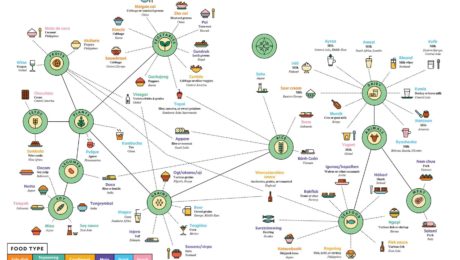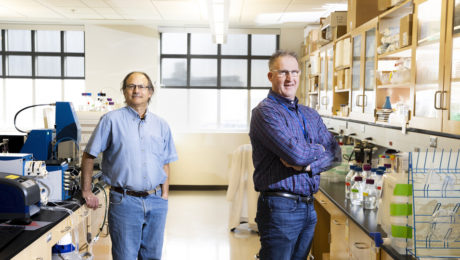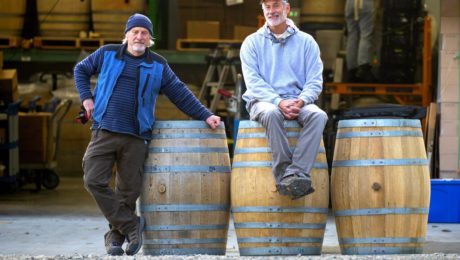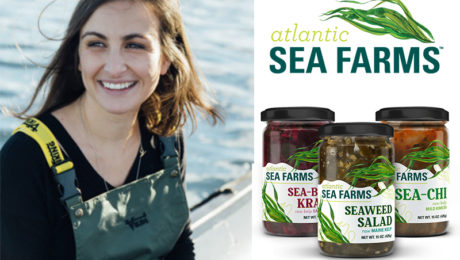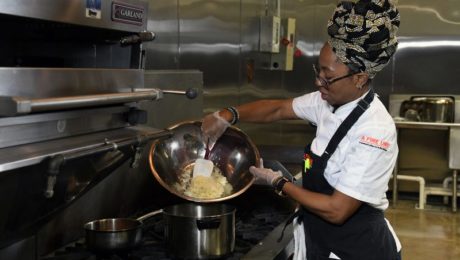The New Definition of Fermented Food
After Dr. Bob Hutkins finished a presentation on fermented foods during a respected nutrition conference, the first audience question was from someone with a PhD in nutrition: “What are fermented foods?”
“I thought ‘Doesn’t everyone know what fermentation is?’ I realized, we do need a definition. Those of us that work in this field know what we’re talking about when we say fermented foods, but even people trained in foods do not understand this concept,” says Hutkins, a professor of food science at the University of Nebraska-Lincoln. He presented The New Definition of Fermented Foods during a webinar with TFA.
Hutkins was part of a 13-member interdisciplinary panel of scientists that released a consensus definition on fermented foods. Their research, published this month in Nature Reviews Gastroenterology & Hepatology, defines fermented foods as: “foods made through desired microbial growth and enzymatic conversions of food components.”
“We needed a definition that conveyed this simple message of a raw food turning into a fermented food via microorganisms,” Hutkins says. “It brings some clarity to many of these issues that, frankly, people are confused about.”
David Ehreth, president and founder of Alexander Valley Gourmet, parent company of Sonoma Brinery (and a TFA Advisory Board member), agreed that an expert definition was necessary.
“As a producer, and having started this effort to put live culture products on the standard grocery shelf, I started doing it as a result of unique flavors that I could achieve through fermentation that weren’t present in acidified products,” Ehreth says. “Since many of us put this on our labels, we should be paying close attention to what these folks are doing, since they are the scientific backbone of our industry.”
Hutkins calls fermented foods “the original shelf-stable foods.” They’ve been used by humankind for over thousands of years, but have mushroomed in popularity in the last 15. Fermented foods check many boxes for hot food trends: artisanal, local, organic, natural, healthy, flavorful, sustainable, innovative, hip, funky, chic, cool and Instagram-worthy.
Nutrition, Hutkins hypothesizes, is a big driver of the public’s interest in fermentation. He noted that Today’s Dietitian has voted fermented foods a top superfood for the past four years.
Evidence to make bold claims about the health benefits of fermentation, though, is lacking. Hutkins says there is observational and epidemiological evidence. But randomized, human clinical trials — “the highest evidence one can rely on” — are few and small-scale for fermented foods.
Hutkins shared some research results. One study found that Korean elders who regularly consume kimchi harbor lactic acid bacteria (LAB) in their GI tract, providing compelling evidence that LAB survives digestion and reaches the gut. Another study of cultured dairy products, cheese, fermented vegetables, Asian fermented products and fermented drinks found that most contain over 10 million LAB per gram.
Still, the lack of credible studies is “a barrier we have to get past,” Hutkins says. There are confirmed health benefits with yogurt and kefir, but this research was funded by the dairy industry, a large trade group with significant resources.
“I think there’s enough evidence — most of it through these associated studies — to warrant this statement: fermented foods, including those that contain live microorganisms, should be included as part of a healthy diet.”
New FDA Requirements for Fermented Food
By August, any manufacturer labeling their fermented or hydrolyzed foods or ingredients “gluten-free” must prove that they contain no gluten, have never been through a process to remove gluten, all gluten cross-contact has been eliminated and there are measures in place to prevent gluten contamination in production.
The FDA list includes these foods: cheese, yogurt, vinegar, sauerkraut, pickles, green olives, beers, wine and hydrolyzed plant proteins. This category would also include food derived from fermented or hydrolyzed ingredients, such as chocolate made from fermented cocoa beans or a snack using olives.
Read more (JD Supra Legal News)
The World of Fermented Foods
In the latest issue of Popular Science, a creative infographic illustrates “the wonderful world of fermented foods on one delicious chart.” It represents “a sampling of the treats our species brines, brews, cures, and cultures around the world,” and is particularly interesting as it shows mainstream media catching on to fermentation’s renaissance. Fermentation fit with the issue’s theme of transformation in the wake of the pandemic.
Read more (Popular Science)
- Published in Food & Flavor
Deciphering Real Fermented Products?
Consumers wanting fermented products must be careful shoppers, cautions Bob Hutkins, Khem Shahani Distinguished Professor of Food Science at the University of Nebraska-Lincoln. [Hutkins, at left in photo, will be speaking at the March 16 TFA webinar on The New Definition of Fermented Food.]
Many products considered fermented (and even labeled fermented) actually contain no live microbes. Sauerkraut stored in a can at room temperature, for example, was heat treated, so the live microbes were killed. He advises to look for products that say “not pasteurized” or “not heat treated.”
So what role do fermented foods play in our gut microbiome? Hutkins says: “The microbes transform proteins into amino acids and sugars into organic acids and they produce vitamins directly in the food. We benefit from that. For example, certain yogurts are more digestible and contain more vitamins than the milk from which they were made. Once we consume those products, the microbes have a chance to reach the gut. Now, we know they do not take up permanent residence, but they could live there for a short period of time and in doing so, they can outcompete pathogens, displace unwanted organisms, and again, produce vitamins and other bioactive molecules directly in the gut.”
Hutkins and Andy Benson, Professor of Food Science at the University of Nebraska-Lincoln, launched Synbiotic Health last year. The company brings their research into the gut microbiome to the marketplace.
Read more (Nebraska Today)
Keeping Traditional Fermentation Alive
Britt’s Fermented Foods is one of the only pickle companies in America still using oak barrel fermentation — how pickles were first fermented in ancient Egypt. But this method is often difficult and time-consuming, and many producers abandoned it in the 1970s when food regulation laws changed.
“The oak barrel has that ability to act as an agent in the fermentation,” says owner Britt Eustis. He explained to The Seattle Times that “the tannins in the oak barrels suppress the enzyme that naturally occurs and makes pickles turn soft,” keeping Britt’s pickles crisp.
Britt’s, with a warehouse on Whidbey Island in Washington, nearly shut down in 2019 due to mounting debt and production challenges. But a blueberry farm on the island offered to partner with the company, offering financial backing and helping to diversify income streams. Britt’s now sells kimchi and sauerkraut, also fermented in oak.
Read more (Seattle Times)
- Published in Business, Food & Flavor
Q&A with CEO of Atlantic Sea Farms
Atlantic Sea Farms began 2020 with landmark accomplishments. Their food service partnerships were bigger than ever, providing ready-cut kelp for David Chang’s kelp bowl created for Sweetgreen restaurants, seaweed kimchi for B.GOOD restaurant’s burgers and a kelp puree for salad dressing at Western Pennsylvania restaurant Lil’ Bit.
Then the coronavirus pandemic business shuttered restaurants, and Atlantic Sea Farms — which had sold 90% of their Maine kelp to food service establishments — had to flip their business model. Their new fermented products (Fermented Seaweed Salad, SeaChi, SeaKraut) and frozen Ready-Cut Kelp and Kelp Cubes became the focus of kelp processing. Atlantic Sea Farms will end 2020 processing 900,000 pounds of kelp and selling their retail product in 800 stores.
“People are excited about what we’re doing. We’re fermenting seaweed, and it tastes really damn good. We have retail buyers even at a time when every store is limiting SKUs, and they want our product,” says Brianna Warner, CEO of Atlantic Sea Farms. “The seaweed people typically eat in the United States is imported dry, rehydrated, then dyed with all the same chemicals that’s in Mountain Dew. But we are making a fermented seaweed that’s fresh, healthy and has all the goodness that comes from fermentation and kelp.”
Atlantic Sea Farms launched nine years ago as the first seaweed farm in the country. The majority (98%) of seaweed Americans eat is imported from Asia dried and unnaturally dyed. American-grown seaweed is still a new concept. When Warner became CEO two years ago, she set big goals for the small company. She wants Atlantic Sea Farms to provide alternative income sources for Maine’s lobster farmers, clean the water to aid climate change and make healthy food. They’ve increased the amount of kelp they produce to 14 times what they did two years ago and, by 2021, they will be in retail locations all over the U.S.
Coming on the heels of numerous awards for their one-of-a-kind, fermented kelp-based products, Warner spoke with TFA about Atlantic Sea Farms.
TFA: Tell me how your work at the Island Institute (Maine’s community sustainability non-profit) introduced you to Atlantic Sea Farms.
Briana Warner: At the time, Atlantic Sea Farms was called Ocean Approved and they were basically just a farming company. They were growing seeds and farming and I’m a development economist by trade. I was in the foreign service for a number of years before I moved to Maine. And the big question that the Island Institute was trying to solve and why they hired me as their first economic development director is we’re so dependent on this natural resource, which is lobster. It’s a lobster monoculture, we’re one of the most rural states in the country, we’re the oldest state in the country as far as demographics go, and there’s very little else in many of these communities other than lobster. There just is no diversity.
At the same time in Maine, we’ve had 10 of the best lobster farming years in the past 20 years. But that is worrying. Why? We know the Gulf of Maine is warming faster than 99% of oceans worldwide, and we know that’s because there’s arctic ice melt that’s creating a confluence of currents that gives the best opportunity for lobsters to thrive here. But what that ultimately means is it will continue to warm. And it will continue to warm to the point that lobsters are no longer surviving at the rate than they’re surviving now.
So with my economic development background, the ultimate solution is to provide alternative supplemental sources of income now while people have the money to invest in it. This is a way to absorb some of the shock of that lobster volatility so that in 10, 15, 20, 30, 40 years, whenever it is that lobster isn’t as secure as it is now. And it’s not secure now either — we know there will be lobsters now, we just don’t know where the price is, we don’t know where it will go, that’s some of the volatility, and all the eggs are in that basket.
The ultimate proof of concept is if we’re able to help people adapt to this kind of economic change and at the same time, mitigate some of its climate change effects. Because when you plant seaweed, you’re actually removing carbon and nitrogen from the water and reducing acidification locally. So it’s this incredible crop that’s off season to the lobster income.
I started working with fishermen to start getting them into seaweed, but the problem is there is no institutional buyers at scale in the entire country. We were the first commercial seaweed farm in the country, when I joined, they were just farming their own seaweed but not buying anything from anyone else. So we really had to think big about what could the supply chain look like? And how could we make this a viable alternative income for fishermen?
The answer to that is, first, make a good product that people want. Second, make sure that that money goes back to the fishermen. And that’s really what our entire business model is based around. Coming up with products that are really delicious, putting them out there in a way that’s accessible, because right now 98% of the seaweed that we eat in the United States is imported, Fresh seaweed is not something anyone has had in the United States. This is a totally different product from the very very cheap stuff that comes from Asia, and it’s a very clean product because it’s grown in the clean, cold waters of Maine by independent fishermen farmers. And it tastes good. Our supply chain that we’ve built from that narrative, we create all the seeds in house, we give them out to our farmers for free, then we guarantee purchase of every single blade of kep that they grow.
When someone is buying a jar of our Fermented Seaweed Salad, that money is going back quite literally into the pockets of fishermen because our whole supply chain is built around as much as we can sell, the more we can put in the water and buy. Then we can make the ocean cleaner, we can make the coast healthier from an economic perspective, and the products are really good for the consumer and taste good. So it’s sort of this five-legged stool that we’re constantly working towards.
TFA: How does kelp farming work?
BW: Our fishermen usually have four-acre farms, so you lease the water. You have to get a permit and a lease (from the state), which takes many months if not years. And we help them with all of that. We provide all the technical assistance for their site selection and leasing requirements. And then on four acres, they put two mooring balls at either end of about 1,000 foot of line, and they do this 13 times on the farm. They put it about 7-feet under water, so all you can see is mooring balls. They put it on these 1,000-foot, horizontal ropes and the kelp starts growing. Kelp grows up to 6-inches a day in the warmer summer months. So it really grows very quickly. We harvest what we call a baby kep because it’s so young. Because it’s at the top of the water column, its this incredibly high-quality food that allows us to serve it fresh in a way that wild harvest wouldn’t because wild harvest you don’t know if you’re getting a 4-year-old plant or an 8-year-old plant whereas, with us, we’re harvesting very young, very tender, very clean kelp that’s at top of the water column.
Right now, we work with 24 kelp farmers. It’s owner-operator run, they have the license to fish and own their own boat. Our farmers work lobster season from June to November, plant our kelp seeds in November and December, then start harvesting them in April. Kelp is the inverse of lobster season.
TFA: Atlantic Sea Farms was just a kelp farm when you joined the company two years ago. Why expand to commercial products?
BW: We were growing 30,000 pounds of kelp a year when I came on in 2018, and now our kelp farmers are growing 900,000 pounds of kelp a year. We rebranded and came out with all these products in 2019 because 30,000 pounds is such a small scale. Nobody is going to make money from doing that, especially farmers. If we really want to make an impact on the coast, there’s a sense of urgency to build this quickly and make sure that we get the scale that we need so we can actually help absorb some of that shock.
Most lobster in America is actually sold to restaurants. But with COVID, people had absolutely no idea what kind of season they were going into this year. It was terrifying. But we were able to send out an email before kelp harvest season saying “There’s a whole lot to worry about right now, but us picking up is not one of those things. We will be there and we will honor every commitment we have.” And it was not easy. It was very, very challenging. And we did it. Because we know above all else, integrity along this coast is what we’re built on and what we’re doing this for. So if we can’t do that, what are we doing? So we picked up, by the last dollar we had.
We were mostly working in food service, that’s why there was such a big fallout. But we had these fermented products that were used in some food service locations but were mostly part of our regional brand we were building in New England. We have our jars, we have our frozen products. They were just in the region. And we really just turned it on its head and went after buyers of national chains for retail and switched our food service to retail. We’ll be launching in Sprouts in January with our frozen products, we’re in several regions of Whole Foods already and we’ll be in more starting in April, we’re in MOMS, Wegmans, all these places where there are ferments. We feel very blessed and very lucky, we’ve been working our tails off. I can’t quite say it’s worked yet. We’ve got these placements, now we’ve got to slam these out. In June we were in 100 stores but by January, we’ll be in 800 stores.
TFA: What does Maine kelp taste like?
BW: It’s very fresh, very vegetal, very light. For our ready cut, for our cubes and for our fermented salad, We blanche it so it knocks off the sort of low-tide taste. That also gives it the green color because, when you dip seaweed in hot water, it turns bright green, so we don’t ever use any dyes or anything. For our SeaChi and our Sea-Beet Kraut, we use it raw because people want those kick-in-your face flavors. If you like kimchi, you’re not going to be afraid of a pretty hard umami taste. It makes our SeaChi so good to have that deep, ocean flavor on it that you’d usually have to use fish sauce for. The blanched seaweed really tastes super mild. It kind of takes on the flavor of whatever you put in it. It’s loaded with calcium, potassium and iodine.
TFA: Have you seen Americans’ perceptions of eating seaweed change? Do you think their perceptions of fermented food have changed, too?
BW: Absolutely. With seaweed, two of the top importers of seaweed are Trader Joes and Costco. People are eating it. There’s nori sheets everywhere and there’s sushi restaurants in the farthest reaches of America. It’s everywhere. People have definitely gotten a taste for seaweed. It’s new for Americans to have it in a form that’s not dried. People want to know where their food comes from, they want to know the food they are eating is regenerative, which is what kelp is, it’s taking carbon and nitrogen out of the water. We don’t use any arable land, we have no fertilizer, we have no fresh water, it’s like this climate change diet dream, everything in it is better for the environment. People also want to know the people connected to it — all our products have the faces of our farmers on it — it checks all those boxes. Let alone it tastes good and it’s good for you.
That’s similar with fermentation. Years ago, fermentation might have been ripe to have it on the menu, but quite frankly, everything out there wasn’t that good. It was these plastic bags of sauerkraut that tasted like pork and sauerkraut. There wasn’t anything else out there. Then you saw some kimchi coming out in the market that you didn’t really know what it said because there wasn’t a whole lot of English writing on it. Then the branding started coming and it started being in more food. For fermentation, it’s been a slow but obvious move because it’s good for you and, again, it tastes good. We just have to take the intimidation factor out, and I think fermentation did that already, and now we’re trying to do that with seaweed.
TFA: Why ferment seaweed?
BW: Part of it is that’s the best way to store it. But the other part of it, the Venn diagram between people who eat kimchi and people who are excited about beet kraut and fermented foods and those who aren’t intimidated at all by seaweed is pretty overlapping. There are few people who say “I like fermented food — but seaweed, ew.” The low hanging fruit is so substantial. That’s kind of our first folks we can approach, they can be our true believers and then they help us advocate for what we’re doing.
TFA: How much time did it take to perfect these recipes?
BW: I’d been playing with them for years. SeaChi was something I was doing — buying kimchi and putting our kelp in it. And the Sea-Beet Kraut came from the fact that beets and kelp really go well together, they’re both very sweet and ferment well together. We spent months trying to figure out how to not make that sugar turn it into a mess of purple explosion.
But we started working with this wonderful company called Chi Kitchen Foods based out of Rhode Island, and they make kimchi and vegan kimchi. So we basically took the recipes as far as we could take it, then we brought it to Minnie (Minnie Luong, founder Chi Kitchen Foods) and basically begged her to help us figure it out. Our speciality is in kelp. We do all the kelp, and then they make the kimchi. They basically helped us commercialize our fermented products.
TFA: Tell me about being a female CEO. Females often make the purchasing decisions for the home. What perspective do you bring to the table?
BW: On top of female CEO, female CEO in seafood. That’s been rarer. Seafood is a white male-dominated category. Most of the fishermen we work with are men — we have one woman.
We have an absolutely broken food system. Things don’t work. People aren’t making more money who are producing the food. The good food is not getting cheaper, and the bad food is getting cheaper. Food is one of the biggest polluters to our planet. Our priorities in what we eat and how to get the food to our table are completely off center and completely broken and creating a massive devastation both on our health and on the health of the environment.
This is not to slight my male counterparts, but that thinking happened under the leadership of men. So instead of taking the same thinking and trying to slightly adjust it, let’s absolutely rethink how we look at our food system. That’s going to take different minds, and it’s going to take different approaches. And I think women are in the best position to do that. We want to feed our children and we want to feed our planet. We look beyond five years in the future. Our plan is our grandchildren and the health of our families and the health of us. While that may be a vast generalization, I think we really need to look at who broke the system and how we can fix it. And that’s going to take all types of thinking.
TFA: Where do you see the future of fermented products?
BW: The future of fermented foods is wide open. We’ve seen, there’s been such a shift in the past year or two in branding, flavor. It used to be sort of this niche thing of a few sauerkrauts and kimchis that all varied in taste only slightly. Then everyone started doing a bunch of cool stuff with those products in their home kitchens or in restaurants. But you couldn’t find those cool things on the shelf. I think we’re starting to see people looking beyond cabbage and recognize that fermentation can happen in so many forms. Just like the homebrewers spurred craft brewers. People are realizing there’s a lot of innovation to be had and buyers are realizing the fermented category isn’t limited to just health food people anymore. It’s people who really want to get those probiotics but also the flavor of the fermentation in the first place. Kombucha has shown us that, obviously. There’s a lot of different forms of fermented stuff out there right now that people are going to simply because it says the word fermented. The possibilities, I think we’re just at the beginning.
- Published in Business, Food & Flavor
Sauerkraut on the Side for the Holidays?
The Baltimore Sun highlights a “hyperlocal tradition”: Black Marylanders serving sauerkraut as a side dish for Thanksgiving and Christmas dinner. Sauerkraut on the holiday table is not uncommon for Americans of German and Polish descent, but the connection to Black Marylanders has a “complicated racial history.”
According to Adrian Miller, food historian, “Germans, who accounted for one in four Baltimoreans when Abraham Lincoln declared Thanksgiving a national holiday, employed freed Black domestics, in addition to owning slaves. Black cooks most likely learned to prepare the meals in German kitchens, according to Miller.” Miller added: “What usually happens in these narratives is that you have enslaved cooks making this food, and they are familiar with it. Not always, but often these foods get incorporated into African American foodways when they have time to cook on their own and have more autonomy of what they cook. They remember these dishes that they cooked for slaveholders and, so then those dishes transition to African American foodways.”
The article notes Black Marylanders make their own spin on the fermented cabbage dish. They add pig tail, neck bones or smoked turkey.
Read more (Baltimore Sun)
- Published in Food & Flavor
Retail Sales Trends for Fermented Food and Beverage
Kimchi, fermented sauces and tempeh are driving growth in the fermented food and beverage category, a $9.2 billion industry that’s grown 4% in the last year.
“We’re excited about the growth potential for fermented food. While fermented food represents about 1.4% of the market today, there are segments that are tracking well above the growth of food and beverage [overall] that are poised for disruption in the future,” says Perteet Spencer, vice president of strategic solutions at SPINS. Spencer shared this information in a recent webinar hosted by The Fermentation Association. “There’s a ton of opportunity to scale and increase the footprint of these products.”
SPINS spent weeks working with TFA to define the fermentation industry’s sales, drilling into 10 fermented product categories and 57 product types. Wine, beer and cheese sales were excluded from the data — those categories are very large, and would obscure trends in smaller categories. (All three are also well-represented by other organizations.)
Pickles and fermented vegetables “is a space that’s seen [a] pretty explosive uptick in growth over the past year,” Spencer says. Every segment is growing — kimchi, sauerkraut, beets, carrots, green beans, sliced and speared pickles and all other vegetables — with pickles the largest, nearly 60% of the category.
The biggest growth, though, is coming from products other than pickled cucumbers. Kimchi is at the center of numerous consumer retail trends. Consumers are purchasing healthier food made with fewer ingredients, and they want food with international flavors. Kimchi makes up only 7% of the category, but sales are increasing at an explosive 90% growth rate.
More people are experimenting with fermenting while they’re at home during the coronavirus pandemic, but these kitchen DIYers do not appear to be detracting from sales.
“The more people make fermented foods, they appreciate what’s available in the store that maybe didn’t exist five or 10 years ago,” notes Alex Lewin, author and TFA advisory board member who moderated the webinar. “Anyone who has made kimchi knows it takes a lot, it makes a big mess, you get red pepper powder stuck under your fingernails and onion in your eyes. I can make kimchi (at home), and then once I’ve made kimchi, I’m like ‘Ok, maybe next time I’ll buy it.’”
Fermented sauces are also growing, up 24% in 2020. The largest segment in sauces is, of course, soy sauce, almost 85% of the category. But gochujang, less than 2% of the category, is increasing at over a 56% growth rate.
Versatility is helping sauces, pickles and fermented vegetables, Spencer says. Any food product with multiple uses is selling well. The condiments and sauces can be used as a topping on eggs, hamburgers or pizza, or mixed-in a salad, rice dish or soup.
Sake, plant-based meat alternatives and miso had combined annual growth of $75 million in 2020. Sake grew 16%, and both plant-based meat alternatives and miso each grew 26%.
Yogurt and kombucha still dominate the fermented food and beverage market. Yogurt is 81% of the market; if yogurt is removed, kombucha is 51% of the remainder.. Both have experienced slowdowns in sales from their peaks. Kombucha sales have slowed recently, as grab-n-go opportunities have shrunk during the pandemic.
Yogurt giant brands Chobani, Yoplait and Dannon still dominate the category, as do GT Kombucha, Health-Ade and Kevita reign for kombucha.
Spencer notes the 4% growth rate of fermented products overall would be higher without yogurt. It’s a large category that — despite an uptick in 2020 during the pandemic – has been fairly flat in recent years. Core (traditional) yogurt has been growing at a 1.6% rate; Greek yogurt, at about twice that pace. Those two segments account for roughly 80% of the category.
“This is an opportunity for disruption for emerging brands,” Spencer says. “We’re already seeing some of the legacy segments start to get disrupted by new innovation, so I’m excited to see the evolution of that innovation and where that goes and kind of what opportunities peek out of that.”
“Overall, we’re seeing historically small segments gaining traction in the marketplace,” Spencer adds. “The pandemic has brought a renewed consumer focus on the fermented space.”
Though fermented products have an added healthy benefit, customers are looking for delicious flavor first.
“In these fermented categories we covered today, taste first is always really important. I think people are going to these categories for different taste experiences,” Spencer says. “If you can level up with a functional benefit, that’s fantastic, but we have to balance the taste first. If it’s highly functional but doesn’t taste good, it just doesn’t have the same success.”
- Published in Business
Whole Foods Market Forecasts Top 10 Food Trends for 2021
Today, Whole Foods Market global buyers and experts unveiled their top 10 anticipated food trends for 2021 in the retailer’s sixth annual trends predictions. Hard kombucha, upcycled foods, leveled-up breakfasts and jerky made from produce are among the food influences expected to take off in the next year.
Each year, a Trends Council of more than 50 Whole Foods Market team members, including local foragers, regional and global buyers and culinary experts, compile trend predictions based on decades of experience and expertise in product sourcing, studying consumer preferences and being on the frontlines with emerging and existing brands. Significantly influenced by the state of the food industry, the 2021 trends report reveals some of the early ways the food industry is adapting and innovating in response to COVID-19 for a post-pandemic food world.
“There have been radical shifts in consumer habits in 2020. For example, shoppers have found new passions for cooking, they’ve purchased more items related to health and wellness, and more are eating breakfast at home every day compared to pre-COVID,” said Sonya Gafsi Oblisk, Chief Marketing Officer at Whole Foods Market. “Food trends are a sign of the times, and our 2021 trends are no exception.”
While Whole Foods Market’s predictions for 2020, including regenerative agriculture, new varieties of flour and meat-plant blends, continue to evolve, the 2021 trends represent what’s new and next for the coming year and what consumers should expect to see on the food scene.
Whole Foods Market’s top 10 food trend predictions for 2021:
WELL-BEING IS SERVED
The lines are blurring between the supplement and grocery aisles, and that trend will accelerate in 2021. That means superfoods, probiotics, broths and sauerkrauts. Suppliers are incorporating functional ingredients like vitamin C, mushrooms and adaptogens to foster a calm headspace and support the immune system. For obvious reasons, people want this pronto.
Try the Trend: Cleveland Kraut: Roasted Garlic, Gnar Gnar; Beekeeper’s Naturals B.Powered Superfood Honey; Om Mushroom Superfood Mighty Mushroom Broth; Navitas Organics Superfood+ Adaptogen Blend Smoothie Booster; Health-Ade Kombucha PLUS: Belly Reset, Beauty, Energy; fresh exotic citrus fruits like Buddha’s Hand
EPIC BREAKFAST EVERY DAY
With more people working from home, the most important meal is getting the attention it deserves, not just on weekends, but every day. There’s a whole new lineup of innovative products tailored to people paying more attention to what they eat in the morning. Think pancakes on weekdays, sous vide egg bites and even “eggs” made from mung beans.
Try the Trend: 365 by Whole Foods Market Atlantic Salmon (coming 2021): Hot Smoked, Cold Smoked; Just Egg Folded plant-based “eggs”; Whole Foods Market Dutch-Style Pancake Bites; Meatless Farm: Meat Free Sausage Patties, Meat Free Breakfast Sausages; 365 by Whole Foods Market Organic Gluten Free Pancake & Waffle Mix; Whole Foods Market Uncured Ham & Gruyère Cheese Egg Bites; Birch Benders Pancake Keto Cups: Chocolate Chip, Classic Maple; Breakfast Pizza – found at Whole Foods Market’s pizza venues in select regions
BASICS ON FIRE
With more time in the kitchen, home chefs are looking for hot, new takes on pantry staples. Pasta, sauces, spices — the basics will never be boring again. Get ready for reimagined classics like hearts of palm pasta, applewood-smoked salt and “meaty” vegan soup.
Try the Trend: Whole Foods Market Applewood Smoked Salt; Spicewalla Chai Masala spice; RightRice Risotto (coming 2021): Basil Pesto, Creamy Cracked Pepper; Acid League Living Vinegar: Meyer Lemon Honey, Strawberry Rose; Whole Foods Market Hearts of Palm Linguine; Otamot Sauce made with organic vegetables: Organic Essential, Spicy Organic; Upton’s Naturals Vegan Soup: Chick Tortilla, Italian Wedding
COFFEE BEYOND THE MUG
The love affair between humans and coffee burns way beyond a brewed pot of joe. That’s right, java is giving a jolt to all kinds of food. You can now get your coffee fix in the form of coffee-flavored bars and granolas, smoothie boosters and booze, even coffee yogurt for those looking to crank up that breakfast parfait.
Try the Trend: Jameson Cold Brew Irish Whiskey; Marge Granola Georgetown Coffee Nib Muesli (coming 2021); 365 by Whole Foods Market Coffee & Almond Protein Chewy Bites (coming late 2020); EVOLVED Coffee Keto Cups; Nancy’s Oatmilk Non-Dairy Yogurt – Cold Brew Coffee with Vanilla; Blender Bombs Coffee, Almond Butter & Cacao Smoothie Booster
BABY FOOD, ALL GROWN UP
Thanks to some inspired culinary innovation, parents have never had a wider or richer range of ingredients to choose from. We’re talking portable, on-the-go squeeze pouches full of rhubarb, rosemary, purple carrots and omega-3-rich flaxseeds. Little eaters, big flavors.
Try the Trend: 365 by Whole Foods Market new Organic Baby Food: Pear Strawberry Rhubarb, Apple Pumpkin Blueberry with Ground Chickpeas, Apple Butternut Squash with Ground Oats and Turmeric; Happy Baby Organics (coming 2021): Sweet Potatoes & Olive Oil with Rosemary; Purple Carrots, Cauliflower & Avocado Oil with Oregano; Pumpkin Tree Organic Mango Purée with Oat Fiber & Seeds + a squeeze of Orange; Once Upon a Farm Organic OhMyMega Veggie! with Ginger and Flax Seed
UPCYCLED FOODS
Peels and stems have come a long way from the compost bin. We’re seeing a huge rise in packaged products that use neglected and underused parts of an ingredient as a path to reducing food waste. Upcycled foods, made from ingredients that would have otherwise been food waste, help to maximize the energy used to produce, transport and prepare that ingredient. Dig in, do good.
Try the Trend: The Ugly Company: 100% Upcycled Kiwis, Apricots and Peaches; Pulp Pantry Pulp Chips (coming 2021): Barbecue, Jalapeño Lime, Salt ‘n’ Vinegar; Barnana Organic Banana Bites: Peanut Butter, Dark Chocolate Peanut Butter Cup; Renewal Mill: 1-to-1 Baking Flour made from okara, or upcycled soybean pulp; Spudsy Sweet Potato Puffs snacks: Vegan Buffalo Ranch; ReGrained SuperGrain+ Bars made with an upcycled blend of barley, wheat and rye: Manuka Honey, Cinnamon & Turmeric Immunity, Blueberry, Sunflower & Ginger Antioxidant
OIL CHANGE
Slide over, olive oil. There’s a different crop of oils coming for that place in the skillet or salad dressing. At-home chefs are branching out with oils that each add their own unique flavor and properties. Walnut and pumpkin seed oils lend a delicious nutty flavor, while sunflower seed oil is hitting the shelves in a bunch of new products and is versatile enough to use at high temps or in salad dressing.
Try the Trend: 365 by Whole Foods Market Expeller Pressed Walnut Oil; International Collection Pumpkin Seed Oil; 88 Acres Seed Dressing, Smoky Chipotle Dressing with Sunflower Seeds; 365 by Whole Foods Market Grain Free Cassava Flour Tortillas made with sunflower seed oil; innovative menu items from Whole Foods Market in-store venues like PLNT Burger’s Crispy Chik N Funguy Sandwich and Next Level Burger’s Tots and Fries, both made with organic sunflower seed oil
BOOZED-UP BOOCH
We tipped you off about hard seltzer bursting on the scene in 2018, and now alcoholic kombucha is making a strong flex on the beverage aisle. Hard kombucha checks all the boxes: It’s gluten-free, it’s super bubbly and can be filled with live probiotic cultures. Cheers to that!
Try the Trend: Strainge Beast Hard Kombucha: Ginger, Lemon & Hibiscus; Passion Fruit, Hops & Blood Orange; Juneshine Hard Kombucha: Blood Orange Mint, Acai Berry; BOOCHCRAFT Organic Hard Kombucha: Grapefruit Hibiscus; Kombrewcha Hard Kombucha: Ginger Lemon; Wild Tonic Hard Kombucha: Blueberry Basil, Mango Ginger; Jiant Hard Kombucha: The Original, Hicamaya; hard kombucha on tap at Whole Foods Market taprooms
THE MIGHTY CHICKPEA
You can chickpea anything. Yep, the time has come to think beyond hummus and falafel, and even chickpea pasta. Rich in fiber and plant-based protein, chickpeas are the new cauliflower — popping up in products like chickpea tofu, chickpea flour and even chickpea cereal. That’s garbanzo-bonkers.
Try the Trend: Biena Vegan Ranch Chickpea Puffs; Peppi’s Greek Gourmet GreekFreez frozen dessert made with chickpea aquafaba: Orange Chocolate, Mint Chocolate Chip; Chikfu Chickpea Tofu; Three Wishes Cereal made with chickpeas (coming 2021): Cinnamon, Honey; Siete Family Foods Chickpea Flour Tortillas; Banza Pizza made with chickpeas: Margherita, Roasted Veggie
FRUIT AND VEGGIE JERKY
Jerky isn’t just for meat lovers anymore. Now all kinds of produce from mushrooms to jackfruit are being served jerky-style, providing a new, shelf-stable way to enjoy fruits and veggies. The produce is dried at the peak freshness to preserve nutrients and yumminess. If that’s not enough, suppliers are literally spicing things up with finishes of chili, salt, ginger and cacao drizzle.
Try the Trend: Snack Jack Jackfruit Jerky: Cracked Pepper, Sweet Chili; Pan’s Zesty Thai Mushroom Jerky; Solely Organic Fruit Jerky: Mango with Chili & Salt, Pineapple with Chili & Salt, Mango with Drizzled Cacao; Wild Joy Banana Jerky: Original, Chipotle Lime, Ginger Teriyaki; Fat Top Farm Spicy Mushroom Jerky (coming late 2020)
“Try the Trend” products include a variety of items available now or coming to Whole Foods Market stores for either local or national distribution. Shoppers can seek out trending products by visiting Whole Foods Market on Amazon.
About Whole Foods Market
For 40 years, Whole Foods Market has been the world’s leading natural and organic foods retailer. As the first national certified organic grocer, Whole Foods Market has more than 500 stores in the United States, Canada and the United Kingdom. To learn more about Whole Foods Market, please visit https://media.wholefoodsmarket.com.
- Published in Food & Flavor
Fermentation as Metaphor: A Conversation
Fermentation is more than just a food processing technique. Sandor Katz, today’s “godfather of fermentation,” expounds on the metaphorical significance of fermentation in his new book “Fermentation as Metaphor.”
“Fermentation is such a fascinating lens through which to look at the world and the incredible practicality of traditional cultural wisdom,” says Katz, fermentation author and educator, during a webinar hosted by The Fermentation Association. “In the English language, there’s a long tradition of describing things as fermenting that are not foods and beverages. We talk about a period of great musical fermentation, artistic fermentation, political fermentation, culture fermentation, we’ve applied it very widely. This book is really an exploration of that and a reflection of that.”
Katz spoke with his friend Mara King, chef and food professional, and they shared thoughts on how fermentation can be an unstoppable force for change.
“Fermentation is really teaching the world to embrace weird and funky things,” King says. “Take natural wines as an example. There’s a big movement in the world of wine making for using older techniques, using less chemical filtration and clarification methods. What you’re left with is a product that changes year to year and a product that has subtle notes of animal or leather, things you wouldn’t find before. We’re realizing a little bit of horrible is quite wonderful.”
Until the 19th Century, all wine was natural, Katz points out. Winemakers relied on organisms on the skins of the grapes for the flavor. Beer used to be a similarly natural product, but that’s changed as brewers today add yeast strains.
“It’s so much more interesting and complex of a flavor than the mass-produced beer where just a single organism is introduced. Fermentation really encourages people to expand their palates,” Katz says. “Funk is good. Funk makes things interesting. Funk is complexity. What I’ve learned by working with fermented tofu in food, working with natto in food, working with sumbala, the West African condiments that are natto-like, working with fish sauce, is [these ingredients on their own] might taste awful to you, but a little bit can introduce this je ne sais quoi into the flavor of a dish. Complexity is good and even flavors on their own that people might find scary or intimidating.”
The photography featured in “Fermentation as Metaphor” is unique — magnified microbes used in the creation of fermented food and drink. The images, captured with a scanning electron microscope, show the complexity of these microorganisms. Each structure is supported by a smaller structure, with membranes that are highly permeable.
“There continues to be a magic to fermentation, maybe in some ways even more so as fewer people have direct contact with their food. As there’s less wine making, cheese making, [or] baking in our lives that people actually see, these processes become more and more mysterious. [Mystery] has always been an aspect of fermentation because, until very recent times, there was never a clear, rational scientific understanding of what is going on. They were always seen as divine processes with lots of ceremony and ritual attached to them,” Katz adds. “Fermentation takes this neutral, plain food and gives it this really discernable, compelling flavor.”
Katz is already working on his next book, a fermentation travelogue book highlighting what he’s learning about fermentation in his worldwide travels. Katz and King previously filmed a series “The People’s Republic of Fermentation,” sharing the fermentation traditions of southwest China. They were supposed to travel to Taiwan and eastern China earlier this year, but the trip was cancelled due to the coronavirus pandemic. Next on Katz’s “to do” list — exploring the fermented cuisine of West Africa.
For anyone interested in purchasing “Fermentation as Metaphor,” visit Amazon or Bookshop.
- Published in Food & Flavor



